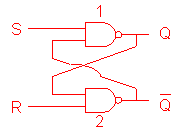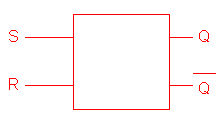 Flip-flops
Flip-flops Flip-flops
Flip-flops Introduction
IntroductionThere are several types of flip-flops : the RS F/F, the D F/F, the JK F/F and the T F/F. Among these flip-flops there are also clocked F/F and master-slave F/F. Only the simplest RS flip-flop built from NAND gates will be covered in this introductory course. The suggested applications are taken from Section 2 of the I.S.M.E.C. Electronics 13-16 Projects Manual [Ref.5]. Students must try to connect and test all the circuits in this part during their practical sessions.
 RS Flip-flop
RS Flip-flop
The simplest RS flip-flop can be constructed from logic gates,
either two NAND gates or two
NOR gates.
Figure 3.1 shows an RS
flip-flop wired from two NAND gates.
It has two inputs S and R
and two complementary output Q and  which are exactly opposite
to each other.
which are exactly opposite
to each other.
 |
 |
| (a) An RS Flip-flop | (b) Symbol |
 Example 3.1
Example 3.1
A very special connection within the flip-flop is the
feedback
path from the output of one NAND gate into the input of other
gate. This characteristic feedback determines the truth table
of the flip-flop as well as its memory property.
For instance,
let us assume that S = 1, R = 1, Q = 0 and  = 1
initially.
If S goes low, the output of NAND gate 1 goes high. Both inputs
of gate 2 are high so that
= 1
initially.
If S goes low, the output of NAND gate 1 goes high. Both inputs
of gate 2 are high so that  = 0. This low signal is fed back to
an input of gate 1 and keeps Q = 1 even if S =1 again. For the
same reason, further change of S to 0 produce no effect.
= 0. This low signal is fed back to
an input of gate 1 and keeps Q = 1 even if S =1 again. For the
same reason, further change of S to 0 produce no effect.
Describe and explain what happens to the flip-flop in example 3.1 if R goes low, then high, then low and then high again. That is, two low pulses are fed to R after the flip-flop has finished the changes described in example 3.1.
 Go to Next Chapter or
Previous Chapter or
Home Page
Go to Next Chapter or
Previous Chapter or
Home Page